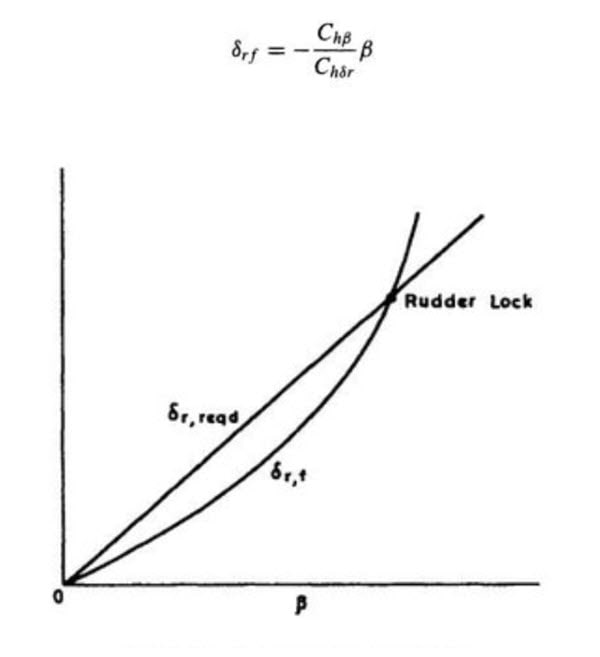# RUDDER LOCK:
Table of Contents:
- What Is Rudder Lock?
- How To Prevent Rudder Lock?
- Aerodynamic Balancing
- Dorsal Fin
What Is Rudder Lock?
The floating angle of the rudder as given by the below equation, depends on the hinge moment parameters Chβ and Chδr. With Chβ > 0 and Chδr < 0, the rudder floating angle δrf will be positive for positive sideslip. Futhermore, the floating angle increases with sideslip. Schematic variations of the required rudder deflection and floating angle with sideslip as shown in the below figure. At high sideslip, the floating angle increases beyond the linear rate indicated by the below equation, because the center of pressure moves aft because of flow separation and stall.
This accentuates the floating tendency of the rudder. At one point, the floating angle may catch up with the required rudder deflection. This condition is usually known as “rudder lock”. Beyond this point, the floating angle may overshoot and opposite pedal forces are required to operate the rudder. Such a situation is undesirable because it may take considerable effort for the pilot to break the rudder lock.
How To Prevent Rudder Lock?
This phenomenon can be prevented by two ways and are,
- Aerodynamic Balancing
- Dorsal Fin
1. Aerodynamic Balancing:
As we have discussed on our previous topics, aerodynamic balancing helps to alter hinge moment coefficients and the floating characteristics of a control surface. Therefore, with proper aerodynamic balancing, the floating tendency of the rudder can be so adjusted that the rudder lock phenomenon is avoided.
2. Dorsal Fin:
Another method of preventing this phenomenon is the use of a device called a dorsal fin. As we know, the stall angle of a given lifting surface increases as the aspect ratio is reduced. Extending the chord of inboard sections adds area without extending the span so that the aspect ratio decreases. This form of extension is known as a dorsal fin as shown in the below figure. Addition of a suitably sized dorsal fin helps to delay the vertical tail stall to higher sideslip and minimizes the possibility of rudder lock. Also, the dorsal fin makes the pedal forces vary monotonically with sideslip.
To find more topics on our website…
Do you want to refer wikipedia? Please click here…


